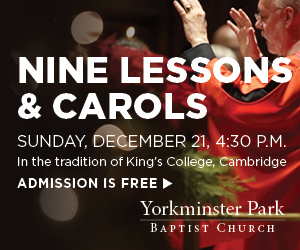The year just ending marked one important milestone in musical history. The first so-called jazz record was issued in 1917 by the Original Dixieland Jass Band (ODJB). Obviously that musical designation, which in its century of existence has gone through as many permutations and retrenchments as so-called classical music has in many centuries, is far different then the ODJB’s primitive efforts. But jazz/improvised music continues to evolve, buttressed by new voices. Here is a group of youngish improvisers who will likely still be contributing to the shape of jazz during its 125th anniversary – and probably for years afterwards.
 First is Vancouver-born, Brooklyn-based pianist Kris Davis, 37, whose presence on advanced jazz sessions over the past half-decade or so has become almost as ubiquitous as Lennon-McCartney tunes at retro-60s parties. Sing Me Some Cry (Clean Feed CF 428 CD cleanfeed-records.com) finds the Canadian pianist in a combo led by bassist Eric Revis, featuring tenor saxophonist/clarinetist Ken Vandermark and drummer Chad Taylor. Although each of the other players has extensive experience, there are points at which Davis dominates. Good Company, for instance, which begins with a J. Arthur Rank-like gong resonation from Taylor’s cymbals and reed asides in brief Morse Code-like dashes, retains its tension from the pianist’s kinetic pressure, with the saxophonist’s peek-a-boo contributions hardening into pressurized honks that unroll in tandem with keyboard tinkling. Obliogo features a middle section where high-frequency piano notes slice kinetically through saxophone snorts and string elaboration from Revis, but maintain the composition’s careful shape. Instructively Rye Eclipse, the one Davis composition, is multi-sequenced and more complex. Mixing Revis’ sliding bass notes with stopped piano keys, Vandermark’s sheets of sounds become staccato just as the piano playing becomes more percussive. The result shapes reed overblowing, string reverberations and complex drum beats into a groove of storytelling and solid forward motion.
First is Vancouver-born, Brooklyn-based pianist Kris Davis, 37, whose presence on advanced jazz sessions over the past half-decade or so has become almost as ubiquitous as Lennon-McCartney tunes at retro-60s parties. Sing Me Some Cry (Clean Feed CF 428 CD cleanfeed-records.com) finds the Canadian pianist in a combo led by bassist Eric Revis, featuring tenor saxophonist/clarinetist Ken Vandermark and drummer Chad Taylor. Although each of the other players has extensive experience, there are points at which Davis dominates. Good Company, for instance, which begins with a J. Arthur Rank-like gong resonation from Taylor’s cymbals and reed asides in brief Morse Code-like dashes, retains its tension from the pianist’s kinetic pressure, with the saxophonist’s peek-a-boo contributions hardening into pressurized honks that unroll in tandem with keyboard tinkling. Obliogo features a middle section where high-frequency piano notes slice kinetically through saxophone snorts and string elaboration from Revis, but maintain the composition’s careful shape. Instructively Rye Eclipse, the one Davis composition, is multi-sequenced and more complex. Mixing Revis’ sliding bass notes with stopped piano keys, Vandermark’s sheets of sounds become staccato just as the piano playing becomes more percussive. The result shapes reed overblowing, string reverberations and complex drum beats into a groove of storytelling and solid forward motion.
Review
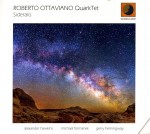 Another pianist who is equally valuable in international collaborations as leader and sideperson is the United Kingdom’s Alexander Hawkins, 36. On Sideralis (Dodicilune Dischi Ed 354 dodicilune.it), he joins veteran American heavy hitters, bassist Michael Formanek and drummer Gerry Hemingway as part of Italian saxophonist Roberto Ottaviano’s QuarkTet, to interpret ten of Ottaviano’s compositions that range from rhythm numbers to ballads. Checking off the saxophonist’s influences, Planet Nichols, Ottaviano’s stop-time salute to pianist Herbie Nichols, gets much of its rollicking shape from Hawkins’ high-frequency key splatters and crescendos, with a walking bass line and cymbal breaks also contributing. At the same time the power of Formanek’s accompaniment on Planet John Lee Hooker, coupled with singular soprano saxophone breaths, makes the tune appear more a salute to Charles Mingus than the Mississippi bluesman. Replete with shadowing of the composer’s every breath on Berenice’s Code, Hawkins’ keyboard caressing preserves the balladic mood while moving the piece linearly. Centaurus’ lilt is cemented by inner piano string plucks that confirm the composition’s jocular theme, with Hemingway’s bell pealing and the pianist’s key slaps and crunches deconstructing and extending the melody until the saxophonist’s tiny reed bites reel it into straight-ahead swing. This same freedom that never exceeds its parameters is displayed on the title tune. Stopped keys and scrubbing slides from the pianist plus the drummer’s rubs provide the perfect contrast to Ottaviano’s intense note puffing. Subsequent return to a rumbling pulse confirms the tune’s gentle motion and the collaborative skill of this ad-hoc quartet.
Another pianist who is equally valuable in international collaborations as leader and sideperson is the United Kingdom’s Alexander Hawkins, 36. On Sideralis (Dodicilune Dischi Ed 354 dodicilune.it), he joins veteran American heavy hitters, bassist Michael Formanek and drummer Gerry Hemingway as part of Italian saxophonist Roberto Ottaviano’s QuarkTet, to interpret ten of Ottaviano’s compositions that range from rhythm numbers to ballads. Checking off the saxophonist’s influences, Planet Nichols, Ottaviano’s stop-time salute to pianist Herbie Nichols, gets much of its rollicking shape from Hawkins’ high-frequency key splatters and crescendos, with a walking bass line and cymbal breaks also contributing. At the same time the power of Formanek’s accompaniment on Planet John Lee Hooker, coupled with singular soprano saxophone breaths, makes the tune appear more a salute to Charles Mingus than the Mississippi bluesman. Replete with shadowing of the composer’s every breath on Berenice’s Code, Hawkins’ keyboard caressing preserves the balladic mood while moving the piece linearly. Centaurus’ lilt is cemented by inner piano string plucks that confirm the composition’s jocular theme, with Hemingway’s bell pealing and the pianist’s key slaps and crunches deconstructing and extending the melody until the saxophonist’s tiny reed bites reel it into straight-ahead swing. This same freedom that never exceeds its parameters is displayed on the title tune. Stopped keys and scrubbing slides from the pianist plus the drummer’s rubs provide the perfect contrast to Ottaviano’s intense note puffing. Subsequent return to a rumbling pulse confirms the tune’s gentle motion and the collaborative skill of this ad-hoc quartet.
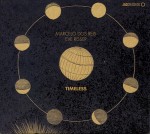 Minimalist and experimental, Timeless (JACC Records 034 jacc-records.com) is a duet between Portuguese guitarist Marcelo dos Reis and French pianist Eve Risser, 35, who made her reputation working in ensembles as different as France’s Orchestra National de Jazz and in a rock-oriented duo. With both instruments prepared with numerous objects, as well as played straight, the selections are compressed and cramped, inhabiting a narrow spectrum, but never abandoning rhythm or feelings. A piece such as Balance Spring, for instance, suggests computer-generated wave forms even though there is no electronic processing. Instead, as the guitarist creates a strummed continuum, the pianist emphasizes carefully thought out patterns, culminating in chiselled movements. In the same way, clanks and crunches from internal piano strings plus external ones on the guitar neck, produce timbres on Hourglass that could have come from a vibraphone. This sound, jolted along with bottleneck-guitar slashes, reaches a thematic crescendo that’s almost lyrical as Riser’s splayed and sharp tones amalgamate into melodic interface. With the tracks reflecting ambience as well as aggression, a piece like the extended Water Clock reflects this strategy in miniature. While dos Reis’ metallic string sawing and percussive strums narrow the interface to a single, almost static line, Risser’s sharp strokes move from aping the guitarist’s heft and power to become chromatic. Eventually, sweeping acoustic piano lines reveal an underlying melody that sets up an unconventional groove.
Minimalist and experimental, Timeless (JACC Records 034 jacc-records.com) is a duet between Portuguese guitarist Marcelo dos Reis and French pianist Eve Risser, 35, who made her reputation working in ensembles as different as France’s Orchestra National de Jazz and in a rock-oriented duo. With both instruments prepared with numerous objects, as well as played straight, the selections are compressed and cramped, inhabiting a narrow spectrum, but never abandoning rhythm or feelings. A piece such as Balance Spring, for instance, suggests computer-generated wave forms even though there is no electronic processing. Instead, as the guitarist creates a strummed continuum, the pianist emphasizes carefully thought out patterns, culminating in chiselled movements. In the same way, clanks and crunches from internal piano strings plus external ones on the guitar neck, produce timbres on Hourglass that could have come from a vibraphone. This sound, jolted along with bottleneck-guitar slashes, reaches a thematic crescendo that’s almost lyrical as Riser’s splayed and sharp tones amalgamate into melodic interface. With the tracks reflecting ambience as well as aggression, a piece like the extended Water Clock reflects this strategy in miniature. While dos Reis’ metallic string sawing and percussive strums narrow the interface to a single, almost static line, Risser’s sharp strokes move from aping the guitarist’s heft and power to become chromatic. Eventually, sweeping acoustic piano lines reveal an underlying melody that sets up an unconventional groove.
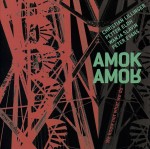 Of course it’s not just pianists who will determine the future of 21st-century improvised music. Horn players and drummers will make their own noises. Take for example two of the players in the Amok Amor (AA) quartet, American trumpeter Peter Evans, 36, and German drummer Christian Lillinger, 33. Their work with alto saxophonist Wanja Slavin and bassist Petter Eldh on We Know Not What We Do (Intakt CD 279intaktrec.ch), shows their interactive skills in one of the many bands in which they participate. It’s the same story with Chicago-based tenor saxophonist Dave Rempis, 42, and drummer Tim Daisy, 41, featured on The Halfway There Suite (Relay Recordings 016 timdaisy.com) by the drummer`s Celebration Sextet. Different discs could find Rempis in the leadership role or both as sidefolk.
Of course it’s not just pianists who will determine the future of 21st-century improvised music. Horn players and drummers will make their own noises. Take for example two of the players in the Amok Amor (AA) quartet, American trumpeter Peter Evans, 36, and German drummer Christian Lillinger, 33. Their work with alto saxophonist Wanja Slavin and bassist Petter Eldh on We Know Not What We Do (Intakt CD 279intaktrec.ch), shows their interactive skills in one of the many bands in which they participate. It’s the same story with Chicago-based tenor saxophonist Dave Rempis, 42, and drummer Tim Daisy, 41, featured on The Halfway There Suite (Relay Recordings 016 timdaisy.com) by the drummer`s Celebration Sextet. Different discs could find Rempis in the leadership role or both as sidefolk.
Composers as well as players – Evans wrote two tunes on We Know Not What We Do and Lillinger three – the key to their talents is how carefully they work in an organized setting, as on Pulsar, the Evans-penned first track. It’s lavish and lovely, notched with contrapuntal slurs and staccato tremors from the horns as the drummer’s percussive bumps and focused rim shots keep the tune bouncy and relaxed. These ambulatory dynamics are also present on Trio Amok, a Lillinger composition, pushed along with percussion bumps and rumbles and resonating pumps from bassist Petter Eldh. While Evans’ spectacular brassiness adds to the tune’s tautness, a respite after he intertwines open-horn brays with staccato tongue flutters from Slavin dissipates the tension. A more striking instance of the drummer’s dexterity is on A Run through the Neoliberalism, another of his compositions, during which altissimo reed squalls and trumpet tattoos set up as a staccatissimo, near-bebop romp. The drummer’s accompaniment may crackle and churn, but as the horns’ work explodes the theme into atoms, his cymbal cascades and rim shots glue it back into a swinging whole. With some of the other tracks utilizing palindromes, balladic melancholy, fiery stomps and rhythmic stop-time sequences, AA keeps the session engaging and moving. The saxophonist and bassist get solo space as well, with the combination of power and bluster from the rhythm section and inventive flutters and echoes from the horns ensuring that while predicting what sounds will appear next is nearly impossible, the knowledge that they will be first-class is confirmed.
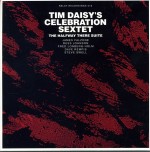 Daisy and Rempis are other first-class sound explorers featured on The Halfway There Suite along with Chicago associates, clarinetist James Falzone, trumpeter Russ Johnson, cellist Fred Lonberg-Holm and visiting New Yorker, trombonist Steve Swell. Composed as a birthday present for himself and the featured musicians, it isn’t clear whether Daisy’s CD title refers to mortality or the length of the four-part suite that lasts only 33 minutes. But like brevity being the soul of wit, the arrangements and solo work are exceptional enough to not need more length. Rempis’ showcase is on Part 2, where his skyscraper-high multiphonics and glossolalia bring energetic freedom to the piece which otherwise flows along with orchestral calm and a steady jazz groove. Falzone’s solo tone is closest to so-called legitimate as he negotiates linkages between the two genres. Swell, and to a lesser extend Johnson, are the disrupters. The trombonist sprays many of the arrangements with gutbucket-styled slurs and tailgate-like elaborations. With the cellist scratching out notes and Daisy replicating kettle-drum-like pressure, Part 3 rolls from crescendos to diminuendos without breaking the melodic continuum. These disparate currents climax in the concluding Part 4, with stop-time polyphony shattered by a clean trumpet blast that joins with cello pumps to herd the sequence into a finale that swings, and neatly refers back to the introduction on Part 1. Throughout, Daisy’s solos, whether involving press rolls and bass drum stomps or freer jumping and double time rhythms, don’t draw attention, but advance the suite.
Daisy and Rempis are other first-class sound explorers featured on The Halfway There Suite along with Chicago associates, clarinetist James Falzone, trumpeter Russ Johnson, cellist Fred Lonberg-Holm and visiting New Yorker, trombonist Steve Swell. Composed as a birthday present for himself and the featured musicians, it isn’t clear whether Daisy’s CD title refers to mortality or the length of the four-part suite that lasts only 33 minutes. But like brevity being the soul of wit, the arrangements and solo work are exceptional enough to not need more length. Rempis’ showcase is on Part 2, where his skyscraper-high multiphonics and glossolalia bring energetic freedom to the piece which otherwise flows along with orchestral calm and a steady jazz groove. Falzone’s solo tone is closest to so-called legitimate as he negotiates linkages between the two genres. Swell, and to a lesser extend Johnson, are the disrupters. The trombonist sprays many of the arrangements with gutbucket-styled slurs and tailgate-like elaborations. With the cellist scratching out notes and Daisy replicating kettle-drum-like pressure, Part 3 rolls from crescendos to diminuendos without breaking the melodic continuum. These disparate currents climax in the concluding Part 4, with stop-time polyphony shattered by a clean trumpet blast that joins with cello pumps to herd the sequence into a finale that swings, and neatly refers back to the introduction on Part 1. Throughout, Daisy’s solos, whether involving press rolls and bass drum stomps or freer jumping and double time rhythms, don’t draw attention, but advance the suite.
On the evidence here, the Celebration Sextet is a lot more than halfway along to reaching musical goals. It’s another confirmation of how from their ideas and those of the players on the other CDs, jazz innovation will thrive in the years to come.



